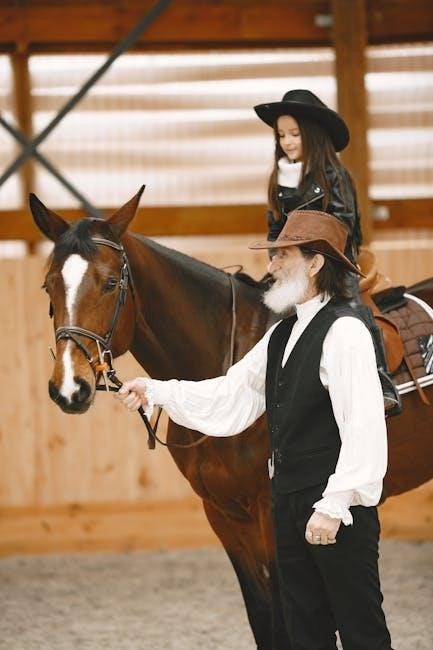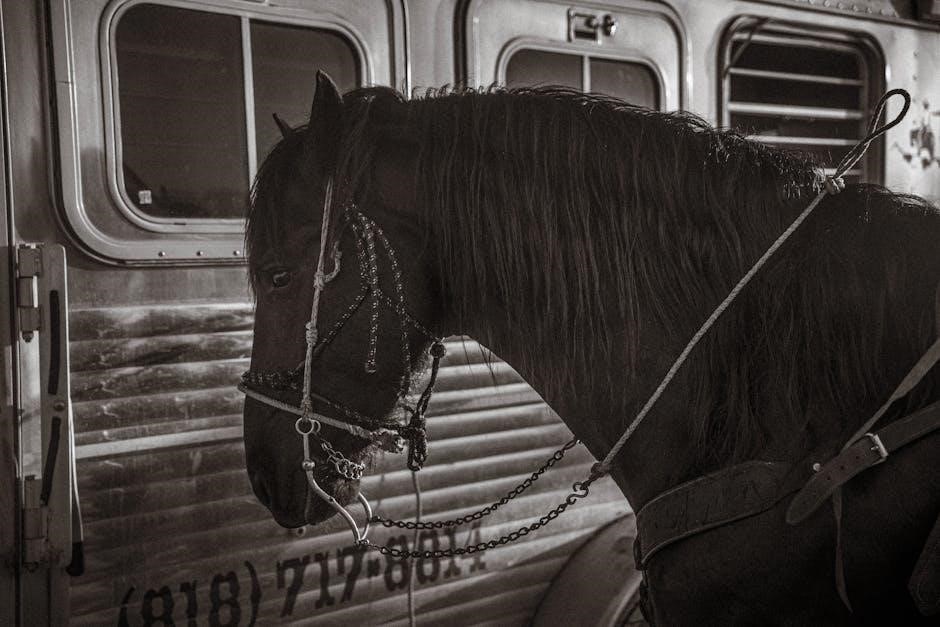This guide explores horse bits and their usage‚ including a brief overview of the topic‚ with relevant information and resources available to horse owners and riders everywhere always.
What is a Horse Bit
A horse bit is a piece of tack that sits on the area of the horse’s mouth that lacks teeth‚ and is used to communicate with the horse and guide its movement. The bit is typically made of metal and is designed to fit comfortably in the horse’s mouth. According to various online resources‚ a horse bit is an essential part of the horse’s bridle and is used to apply pressure to the horse’s mouth‚ cheeks‚ and poll. The bit is usually attached to the reins‚ which are held by the rider‚ and is used to steer the horse and control its speed. A well-designed bit can make a big difference in the horse’s comfort and performance‚ and can help to establish a clear and effective line of communication between the horse and rider. The bit is a crucial component of the horse’s tack‚ and is used in a variety of equestrian disciplines‚ including English and Western riding.

Types of Horse Bits
Various horse bits exist‚ including snaffle and curb bits‚ each with unique characteristics and uses always.
Snaffle and Curb Bits
Snaffle and curb bits are two primary categories of horse bits‚ each applying pressure to different areas of the horse’s mouth.
The snaffle bit is a type of bit that applies pressure to the horse’s lips‚ tongue‚ and bars‚ while the curb bit applies pressure to the chin‚ poll‚ and roof of the mouth.
These bits are used for different riding styles and disciplines‚ with snaffle bits commonly used for English riding and curb bits often used for Western riding.
A simple bit guide can help horse owners and riders understand the differences between these bits and choose the right one for their horse.
Understanding the mechanics of snaffle and curb bits is essential for selecting the correct bit for a horse‚ as it can affect the horse’s comfort and performance.
The choice of bit depends on various factors‚ including the horse’s level of training‚ the rider’s experience‚ and the specific riding discipline.
By considering these factors‚ horse owners and riders can make an informed decision when selecting a snaffle or curb bit for their horse.
This knowledge is crucial for ensuring the horse’s well-being and achieving optimal performance.

Measuring Your Horse for a Bit
Measuring is crucial for a proper fit‚ ensuring the horse’s comfort and performance with correct bit size always.
Importance of Correct Fit
The importance of a correct fit cannot be overstated‚ as it directly affects the horse’s comfort and performance‚ with a proper fit ensuring the bit sits comfortably in the horse’s mouth‚ allowing for clear communication between the horse and rider.
A correct fit is essential to prevent discomfort‚ pain‚ and potential damage to the horse’s mouth‚ and to ensure the horse can respond willingly to the rider’s aids‚ with a well-fitting bit allowing the horse to relax and focus on the task at hand.
The correct fit of a bit is crucial for the horse’s overall well-being‚ and riders should take the time to ensure a proper fit‚ consulting with a professional if necessary‚ to guarantee the horse’s comfort and optimal performance‚ and to establish a strong partnership between the horse and rider.
With a correct fit‚ the horse will be able to perform at its best‚ and the rider will be able to communicate effectively‚ creating a harmonious and successful partnership.
The fit of the bit is a critical aspect of horse riding‚ and riders should prioritize it to ensure the horse’s comfort and success.
A correct fit is the foundation of a successful riding experience‚ and it is essential for riders to understand its importance and take the necessary steps to ensure a proper fit.
Riders should be aware of the potential consequences of an incorrect fit‚ and take the necessary precautions to prevent them‚ by consulting with a professional and following established guidelines for fitting a bit.
By prioritizing the correct fit of the bit‚ riders can ensure a comfortable and successful riding experience for both themselves and their horses.
The correct fit of a bit is a critical aspect of horse care‚ and riders should prioritize it to ensure the horse’s overall well-being and optimal performance.
A correct fit is essential for establishing a strong partnership between the horse and rider‚ and for ensuring the horse’s comfort and success.
Riders should take the time to ensure a proper fit‚ and consult with a professional if necessary‚ to guarantee the horse’s comfort and optimal performance.
With a correct fit‚ the horse will be able to perform at its best‚ and the rider will be able to communicate effectively‚ creating a harmonious and successful partnership‚ and a correct fit is the key to a successful riding experience.

Choosing the Right Bit
Selecting a suitable bit involves considering the horse’s breed‚ age‚ and level of training‚ with expert guidance available to help owners make an informed decision always and every time.
Factors to Consider
When choosing a bit for your horse‚ there are several factors to consider‚ including the horse’s age‚ breed‚ and level of training‚ as well as the rider’s experience and style. The type of riding you will be doing‚ such as English or Western‚ is also an important consideration. Additionally‚ the horse’s mouth and dental structure should be taken into account‚ as some bits may be more suitable for certain types of mouths. A horse with a sensitive mouth‚ for example‚ may require a milder bit‚ while a horse with a stronger mouth may require a more severe bit. It is also important to consider the materials used to make the bit‚ as some horses may be sensitive to certain metals or materials. By taking these factors into account‚ you can choose a bit that is comfortable and effective for your horse‚ and that will help you to achieve your riding goals. With so many options available‚ it can be helpful to consult with a professional‚ such as a trainer or equine dentist‚ to determine the best bit for your horse;

Horse Bit Severity Chart
Bits are rated on a severity scale‚ with milder bits being suitable for young or sensitive horses always.
Understanding Bit Severity
Understanding bit severity is crucial for horse owners and riders‚ as it directly affects the horse’s comfort and performance. The severity of a bit refers to the level of pressure it applies to the horse’s mouth‚ with some bits being milder than others. A bit’s severity is determined by its design‚ material‚ and the way it interacts with the horse’s mouth. Riders should consider their horse’s individual needs and personality when selecting a bit‚ as some horses may be more sensitive to certain types of bits. The bit severity chart is a useful tool for comparing the relative severity of different bits‚ allowing riders to make informed decisions about which bit to use. By choosing a bit that is suitable for their horse‚ riders can promote comfortable and effective communication‚ leading to a better riding experience for both horse and rider. This knowledge is essential for any horse owner or rider.
